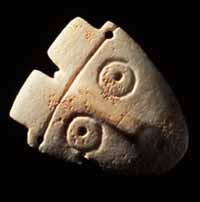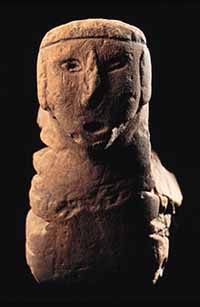
 |
'Long-nosed god' maskette, Emmons site, Fulton County. | |
|
Made from a piece of marine shell (Busycon), this 'long-nosed god' maskette. These shield-shaped maskettes have a squared-off crown, circular eyes, and a large nose of varying lengths. Long-nosed gods are often depicted on shell engravings of falcon impersonators as ear ornaments. The symbolic meaning of these maskettes is obscure. |
||
Corn changed Native American life. It was one of the most productive plants cultivated by Native Americans. The harvest provided sufficient food for the difficult winter months and seed for spring planting. The increased investment in agriculture and related changes in social and religious practices gave rise to a new way of life that archaeologists call Mississippian.
Archaeologists use the term Mississippian because many of the major centers of this new way of life occur in the Mississippi River valley.
 |
Human effigy block pipe, Orendorf site, Fulton County. | |
| In addition to learning how Native Americans made pipes, archaeologists also study where pipes were found. The distribution of pipes provides information on where smoking took place and in what situations. | ||
The Mississippian period begins 1,100 years ago (A.D. 900) and continues in Illinois until 550 years ago (A.D. 1450). Mississippian people lived throughout Illinois. In southern Illinois, they built a village on the crest of Millstone Bluff. In west central Illinois, at the mouth of the Spoon River, they established a large town surrounded by smaller communities, and a large cemetery now known as Dickson Mounds. Near East St. Louis, Mississippian people built Cahokia, one of the largest Native American cities in North America-larger, in fact, than many European cities at the time. Cahokia was a political and religious center of Mississippian life. The magnificence of this center is still visible today in the form of monumental earthworks that dot the Mississippi River flood plain at Cahokia. The largest mound at the site, Monks Mound, is 305 m (1,000 ft)long and nearly 244 m (800 ft) wide at its base, and it stands slightly more than 30 m (100 ft) tall. It is larger at its base than any of the Egyptian pyramids. All of the dirt used to construct this enormous earthwork was moved in baskets by hand. These are a few of the 2,379 Mississippian sites documented so far in Illinois.
Let's explore Mississippian life in more detail.
|
|
Copyright © 2000 Illinois State Museum